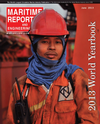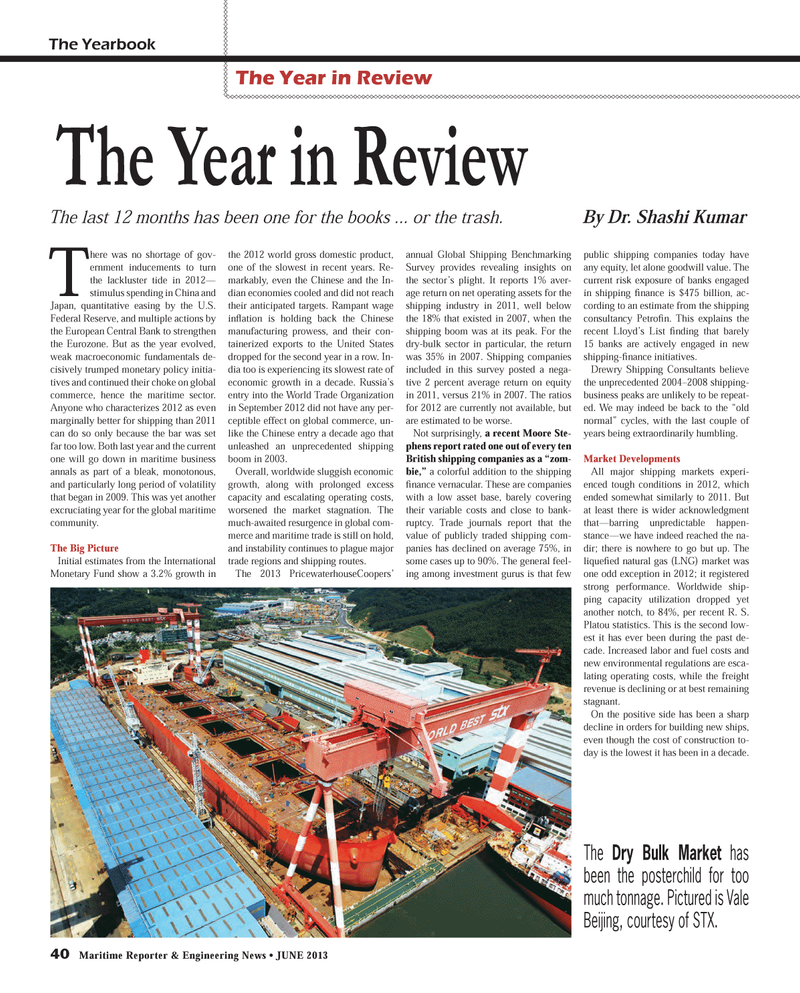
Page 40: of Maritime Reporter Magazine (June 2013)
Annual World Yearbook
Read this page in Pdf, Flash or Html5 edition of June 2013 Maritime Reporter Magazine
40 Maritime Reporter & Engineering News ? JUNE 2013 The YearbookThe Year in ReviewThere was no shortage of gov-ernment inducements to turn the lackluster tide in 2012?stimulus spending in China and Japan, quantitative easing by the U.S. Federal Reserve, and multiple actions by the European Central Bank to strengthen the Eurozone. But as the year evolved, weak macroeconomic fundamentals de-cisively trumped monetary policy initia-tives and continued their choke on global commerce, hence the maritime sector. Anyone who characterizes 2012 as even marginally better for shipping than 2011 can do so only because the bar was set far too low. Both last year and the current one will go down in maritime business annals as part of a bleak, monotonous, and particularly long period of volatility that began in 2009. This was yet another excruciating year for the global maritime community. The Big Picture Initial estimates from the International Monetary Fund show a 3.2% growth in the 2012 world gross domestic product, one of the slowest in recent years. Re-markably, even the Chinese and the In-dian economies cooled and did not reach their anticipated targets. Rampant wage inß ation is holding back the Chinese manufacturing prowess, and their con-tainerized exports to the United States dropped for the second year in a row. In- dia too is experiencing its slowest rate of economic growth in a decade. Russia?s entry into the World Trade Organization in September 2012 did not have any per- ceptible effect on global commerce, un- like the Chinese entry a decade ago that unleashed an unprecedented shipping boom in 2003.Overall, worldwide sluggish economic growth, along with prolonged excess capacity and escalating operating costs, worsened the market stagnation. The much-awaited resurgence in global com- merce and maritime trade is still on hold, and instability continues to plague major trade regions and shipping routes.The 2013 PricewaterhouseCoopers? annual Global Shipping Benchmarking Survey provides revealing insights on the sector?s plight. It reports 1% aver- age return on net operating assets for the shipping industry in 2011, well below the 18% that existed in 2007, when the shipping boom was at its peak. For the dry-bulk sector in particular, the return was 35% in 2007. Shipping companies included in this survey posted a nega-tive 2 percent average return on equity in 2011, versus 21% in 2007. The ratios for 2012 are currently not available, but are estimated to be worse.Not surprisingly, a recent Moore Ste- phens report rated one out of every ten British shipping companies as a ?zom-bie,? a colorful addition to the shipping Þ nance vernacular. These are companies with a low asset base, barely covering their variable costs and close to bank-ruptcy. Trade journals report that the value of publicly traded shipping com-panies has declined on average 75%, in some cases up to 90%. The general feel- ing among investment gurus is that few public shipping companies today have any equity, let alone goodwill value. The current risk exposure of banks engaged in shipping Þ nance is $475 billion, ac- cording to an estimate from the shipping consultancy PetroÞ n. This explains the recent Lloyd?s List Þ nding that barely 15 banks are actively engaged in new shipping-Þ nance initiatives. Drewry Shipping Consultants believe the unprecedented 2004?2008 shipping-business peaks are unlikely to be repeat-ed. We may indeed be back to the ?old normal? cycles, with the last couple of years being extraordinarily humbling.Market DevelopmentsAll major shipping markets experi-enced tough conditions in 2012, which ended somewhat similarly to 2011. But at least there is wider acknowledgment that?barring unpredictable happen-stance?we have indeed reached the na-dir; there is nowhere to go but up. The liqueÞ ed natural gas (LNG) market was one odd exception in 2012; it registered strong performance. Worldwide ship- ping capacity utilization dropped yet another notch, to 84%, per recent R. S. Platou statistics. This is the second low- est it has ever been during the past de-cade. Increased labor and fuel costs and new environmental regulations are esca-lating operating costs, while the freight revenue is declining or at best remaining stagnant.On the positive side has been a sharp decline in orders for building new ships, even though the cost of construction to-day is the lowest it has been in a decade. The Year in Review The last 12 months has been one for the books ... or the trash. By Dr. Shashi Kumar The Dry Bulk Market has been the posterchild for too much tonnage. Pictured is Vale Beijing, courtesy of STX. MR #6 (34-41).indd 40MR #6 (34-41).indd 405/30/2013 1:06:36 PM5/30/2013 1:06:36 PM

 39
39

 41
41
